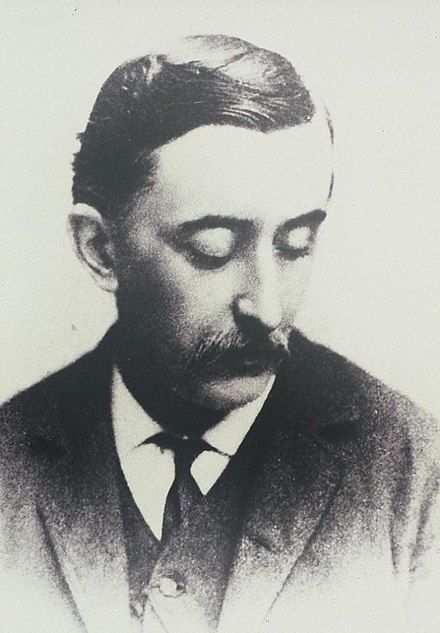At Dublin’s 48 Gardiner St. Lower, a plaque honors the boyhood home of Greek-Irish writer Patrick Lafacadio Hearn, who is barely known in Ireland, but whose widely read books are national treasures in Japan. The plaque reads:
“One of the most fascinating writers of the 19th century. The Celtic spirit of vague unrest and a reaction to Western materialism led him to Japanin 1890. His genius grasped better than anyone else the very essence of Japan. He presented with subtle comprehension and sympathy and in exquisite prose the soul of a people destined to play an ever-increasing role in World Affairs.”
At the end of the 19th century, Hearn was ranked as one of America’s best writers, on a par with Twain, Poe and Robert Louis Stevenson. Twain, but today Hearn’s name has been forgotten. His biography reads like the script of an adventure novel.
Hearn was born in 1850 not far from Ithaca, on the island of Lefkada in Greece, from the union of Charles Bush Hearn, an Irish surgeon in the British army, and Rosa Kassimatis, a Greek woman. The couple married in the Greek Orthodox Church, but Hearn’s Protestant Irish family refused to bless their union.
Throughout his life, Lafcadio honored his Greek blood and displayed a passion for Greek culture, but he left Greece at the age of two never to return when his father received a promotion that meant relocating to the West Indies. Instead of bringing his family to the Caribbean, Dr. Hearn sent them to his unwelcoming Dublin relatives. Lafcadio’s mother Rosa, who spoke no English, could not adapt to Ireland and her husband’s Protestantism. Lafcadio’s grandmother Elizabeth shunned her new Greek daughter-in-law and grandson, but her sister, Sarah Holmes Brenane, a widow who had converted to Catholicism, welcomed Rosa and her infant grandnephew.
When the elder Hearn returned to Ireland in 1853, he saw that his wife had become estranged, and the doctor got an annulment. After learning of the annulment, Rosa almost immediately married Giovanni Cavallini, a Greek citizen of Italian ancestry. Cavallini demanded that Rosa give up Lafcadio, which she did, and Brenane became Lefcadio’s guardian. His father remarried and went off to serve the British Empire abroad and died without ever seeing his Greek-Irish son again. Brenane showed Lefacadio a life of luxury that included winters in Dublin townhouse and summers in Tramore, Co Waterford and Cong, Co. Mayo. Hearn began exploring Brenane's library and read extensively in Greek literature, especially myths.
Much to his guardian’s chagrin, the future writer proved to be indifferent to the Catholic faith. In 1861, Brenane, worried about the boy’s religious indifference, enrolled him at the Institution Ecclésiastique, a Catholic church school in Vyetot, France, where she hoped the boy would become a devout Catholic. Hearn grew to hate the severe form of Catholicism there but fell in love with the French language and its literature. He would later become an important translator of French literature into English.
His great-aunt then sent him to a Catholic school in Durham, England, where he began to call himself Paddy. He suffered a disfigured eye injury during a schoolyard fistfight which caused near blindness in one eye. Hearn’s right eye remained noticeably enlarged for the rest of his life and Hearn was so self-conscious about his appearance after the incident that he often wore wide-brimmed hats or stood in profile to mask his features.
His formal education came to an end at the age of 16 when he was removed from school due to his aunt’s loss of fortune. His Irish family wanted to get rid of Hearn, so they paid for a one-way ticket to the United States. Hearn made his way to Cincinnati, where he had relatives, but again his Irish relatives shunned their Greek-Irish relative.
Hearn experienced dire poverty in Cincinnati, working in a barn and sleeping in the hayloft, but he made friends with a printer. He soon began writing for a Cincinnati newspaper, specializing in grisly “shock reporting,” Hearn became famous for lurid accounts of murders. Immersing himself in local life, he showed an uncanny ability to capture people’s stories in vivid articles. By age 24, he had become the City’s leading journalist. He was also fascinated by Cincinnati’s African-American community. Hearn wrote a series of accounts of the Bucktown and Levee neighborhoods of Cincinnati, one of the few depictions of black life in a border city during the post-Civil War period. He also preserved the lyrics to many African American songs he heard. His marriage to an African American woman, Matty Foley, violated Ohio’s anti-miscegenation laws and caused a massive scandal and led In August 1875, to his newspaper, The Enquirer, firing him. Sadly, his marriage dissolved, and he and Foley divorced.
He came to New Orleans where he remains something of a legend. He started writing first for the newspaper Daily City Item beginning in June 1878, and later for the Times-Democrat. Hearn's editorial work, which dramatically changed journalism there, included book reviews, summaries of pieces in national magazines, and even editorial pieces introducing Buddhism and Sanskrit writings. As editor, Hearn created and published nearly 200 woodcuts of daily life and people in New Orleans, making the Item the first Southern newspaper to feature cartoons. His writings for national publications, such as Harper's Weekly and Scribner's Magazine, helped shape the popular image of New Orleans as an exotic city with a distinct culture. His work, “La Cuisine Créole,” published in 1885, a collection of culinary recipes from leading chefs and noted Creole housewives, helped make New Orleans cooking famous. Hearn's writings for the city’s newspapers also included impressionistic pieces on local places and characters. He was also the first writer to introduce local Voodou legends Marie Laveau and "Doctor" John Montenet.
By 1890, his Celtic wanderlust led him to Japan where he would make lasting contributions to Japanese culture. Hearn became “infatuated” with Japan. He married Koizumi Setsu, the daughter of a samurai, and they had four children. He then became a naturalized Japanese citizen, taking the name Koizumi Yakumo, and he became a Buddhist. In the late 19th century, thanks in part to an exhibition of Japanese culture at the 1900 World’s Fair, the West developed an insatiable appetite for Japan and Hearn became one of the first Westerners to write about the country. Hearn’s seminal book, “Glimpses of Unfamiliar Japan,” published in 1894, captured the country’s unique culture and introduced foreigners to the real Japan. He is most famous for his collections of Japanese folk legend and ghost stories, such as “Kwaidan: Stories and Studies of Strange Things” (1904), a collection of stories of the supernatural and translations of haiku poetry. Hearn’s final work “Japan, an Attempt at an Interpretation” (1904), proved to be a total departure from his earlier, idealized view of Japan. Though getting nearer perhaps than any other Westerner of the time to an understanding of the Japanese, he always regarded himself as an outsider in Japan. He died in 1904 and became the first Westerner to receive a full Buddhist funeral.
The Japanese still adore Hearn. His books have been widely translated and remain very popular. His enduring appeal lies in the glimpses he offered of an older, more mystical Japan lost during the country’s headlong plunge into rapid industrialization and Westernization.
Hearn’s presence looms large over Matsue, the Japanese city where he lived for only 15 months. The remote castle city still claims him as its favorite son, displaying his face on park statues, street signs, and local brands of beer, sake, and even instant coffee. Hearn’s descriptions of this medieval city and its ancient tales of gods and ghosts put Matsue on the map in the 1890s. Even now it is a popular tourist destination, thanks to Japan’s enduring fascination with the Irishman. The Hearn Memorial Museum and his old residence in Matsue are still two of the city's most popular tourist attractions. Matsue also promotes the Hearn legacy with Irish cooking festivals, classes in Gaelic, and even a St. Patrick’s Day parade. The 300-member Hearn Society of Matsue invites scholars for conferences. The city also holds a national speech contest for high school students to read Mr. Hearn’s stories in English.
Ireland has slowly embraced Hearn. Hearn's life and works were celebrated in “The Dream of a Summer Day,” a play that toured Ireland in April and May 2005. In 2015, Dublin’s Little Museum staged an exhibit on Hearn and the same year the Lafcadio Hearn Japanese Garden opened in Tramore, Co, Wexford.
Finally, Dubliner Jean Pasley, who lived in Japan as a young woman, wrote the novel “Black Dragonfly” with Lafcadio Hearn at its heart and it was published to acclaim in 2021 (see the Echo article here about it).







